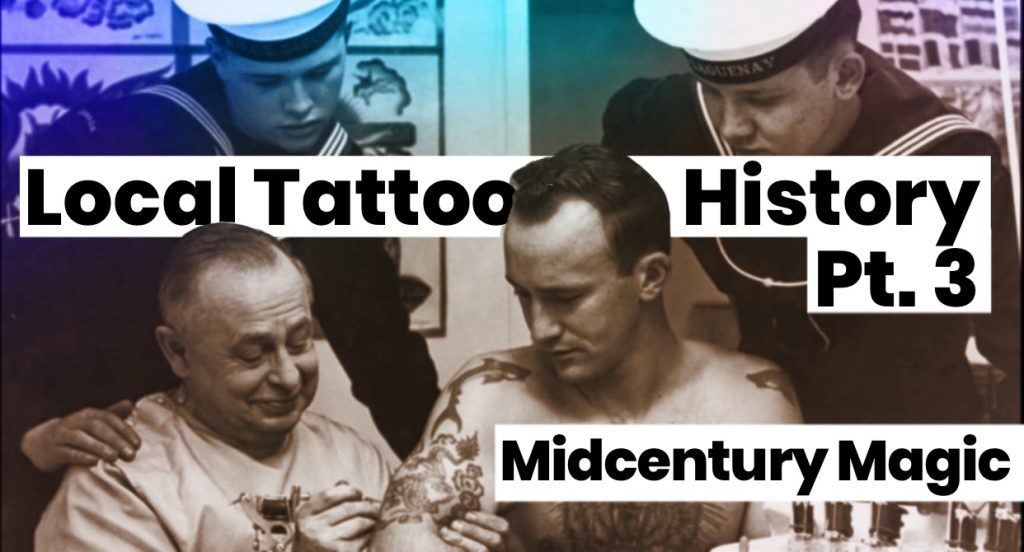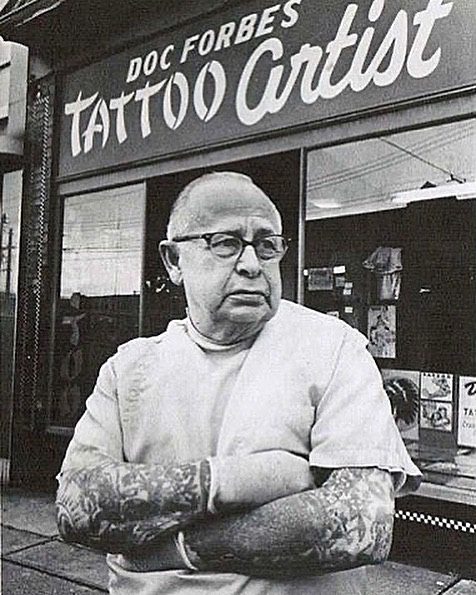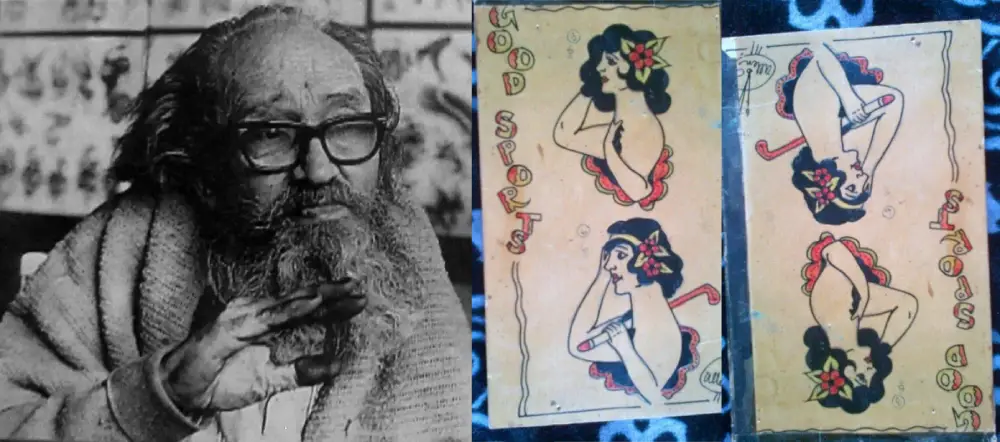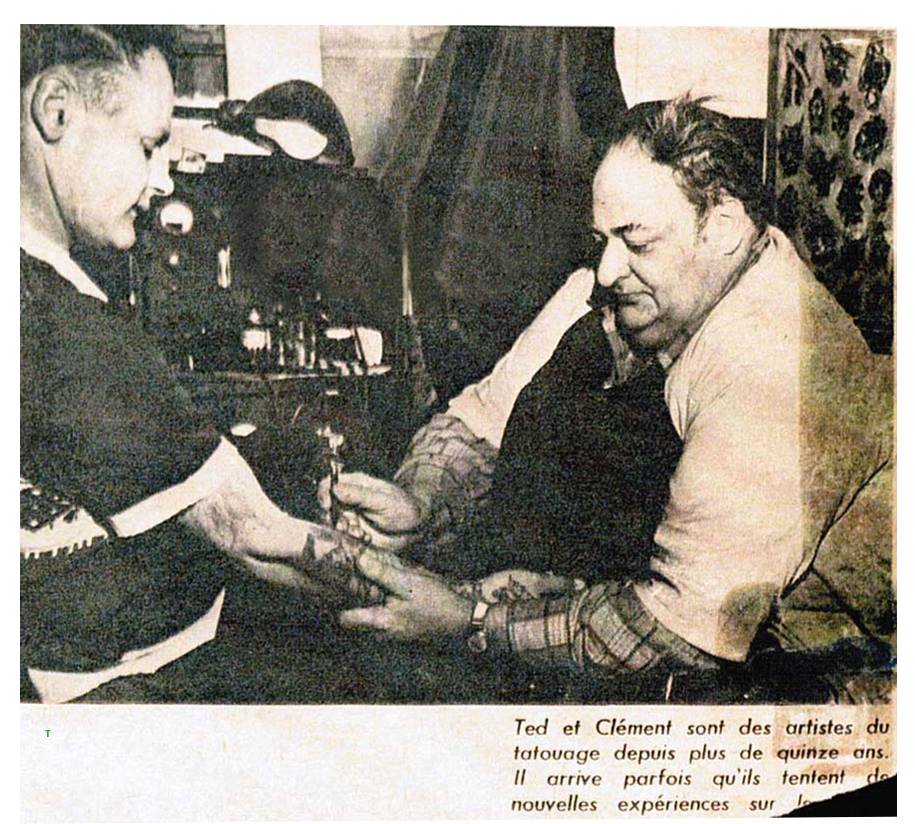
Vancouver’s Tattoo Scene Breaks Out of the Backroom (1938-1970)
By the end of the Depression, Vancouver’s tattoo scene was down—but not out. As the economy began to recover in the late 1930s, tattooing picked up alongside it. With more sailors returning to port and working-class folks flowing back into the city, Vancouver tattoo shops started to see regular business again.
Picking up from Part 2 of this series, which looked at tattooing in Vancouver from the 1890s through the Depression, this post covers the next generation of artists who carried the craft through wartime, cultural change, and an evolving city.
Doc Forbes Hendry: The Traveling Tattooist Who Settled in Vancouver
Born in 1903, Doc Forbes Hendry ran away to join the circus when he was 14. His performed various roles within the circus. He was a magician, acrobat, “human art gallery” as well as a tattooer. He claimed to have been taught by an unknown Hindu tattooer, but it’s more likely he learded from Freddy Baldwin. He married a three foot tall woman he met in the circus known as Wee Jean, famously billed as the “world’s smallest mother.”
In 1938 the family settled in Vancouver and Hendry began tattooing out of 30 ½ East Hastings St. This was only one block east of where Chapman’s and the Wellington Arcade operated. They didn’t stay for long and worked at a series of amusement based locations in Victoria.

Once returning to Vancouver in 1958, Hendry opened up one of the first stand-alone tattoo shops on the 700 block of East Hastings. He emphasized cleanliness and professionalism, setting up his shops to resemble medical clinics with stark white walls and sterilizing equipment. This gave his clients a sense of legitimacy at a time when tattoos were still closely associated with gritty amusement spaces in deteriorating parts of town. Other artists followed suit, marking the end of tattooing out of arcades in BC.
Forbes had an unusually long career for the era and was savvy about maintaining a respectable public image. But Forbes’ success didn’t mean he avoided trouble. Later in life, he was violently attacked at his 628 Davie St studio, which left him shaken. After that, his shop setup changed dramatically. He installed a gate at the front of his workspace and would only allow clients past it if they were getting their torso tattooed. Otherwise, they had to stick just an arm through an opening in the cage while he worked from behind the barrier.
Doc Forbes retired in the early 1970s, having spent decades shaping the look and tone of Vancouver tattooing. He left behind a legacy built not just on skill, but on endurance, adaptation, and a relentless commitment to the trade.
Speedy Robinson: The Quiet One
Speedy Robinson, also known as A.G. Robinson, apprenticed under Doc Forbes and became a staple of Victoria and Vancouver’s tattoo scene in the 1940s and ’50s. He also worked out of 30 ½ East Hastings St more than once, as well as other leisure based spaces such as Veterans Amusements, another location at 50 East Hastings, across from the old Lux Theatre. He also briefly worked at 204 Main Street, a location later demolished to make way for the Ballantyne Pier.
Unlike some of his peers, Speedy kept a lower profile. He tattooed quietly and efficiently, mostly serving Vancouver’s working class. Sadly, he died young in 1958—allegedly due in part to heavy drinking—but his contribution to the city’s tattoo culture lives on.
John “Curly Allen” Wetherhead: THAT guy was a ballroom dancer??
Curly Allen, born John Allan Wetherhead, was one of the most important figures in Vancouver tattooing during this period. He apprenticed under the legendary Charlie Wagner in New York from 1927 to 1929 before relocating to Canada. His nickname came from his curly hair as a kid, but he was known for much more than that.
Curly operated a few Vancouver tattoo shops beginning in the early 60s and gave many of the city’s future artists their first tattoos. His first shop On E Hastings near Columbia St and later moved to 609 E Hastings.

In the later years of his life, after suffering a stroke that left him partially paralyzed, Curly continued to tattoo from a wheelchair—a testament to his dedication. Amazingly, before his stroke, Curly was also a ballroom dancer—something that probably made losing mobility even harder. But he never let it stop him.
He passed away in early 1979, but his impact on Vancouver’s tattoo scene is still felt. Many who were tattooed by Curly remember both his talent and his resilience. He helped mentor artists and preserve a sense of tradition in a trade that was still very much outside the mainstream.
Captain Ted Liberty: A Tattoo Life of Exile and Independence
Originally from Boston, Captain Ted Liberty came from a lineage of tattooers. His father, Edward “Dad Liberty,” was a well-known East Coast tattooist until tattooing was outlawed in Massachusetts in 1962. When Ted moved to Canada in the mid-1950s to pursue his craft, his father reportedly disowned him, seeing the move as a betrayal of the American tattoo scene.
Ted first tattooed in Halifax with Charlie Snow, then Montreal before settling in Vancouver in 1958. His first tattoo shop was located upstairs at the corner of Carrall and Hastings, a prime spot back when the area was packed with sailors, workers, and drifters. Later, he moved his shop downstairs, two doors east on Hastings.

He worked there until 1974, when failing health forced him into a nursing home. Sailor Fred, another Vancouver tattoo figure, took issue with that and broke Ted out, insisting that “a tattooist shouldn’t die in a place like that.” Ted passed away in 1977. According to legend, his unclaimed ashes were tossed into the apartment incinerator.
Circus Leo: The Man with Too Many Shops
Guy Edward Leopold—known professionally as Circus Leo—had one of the most widespread presences in Vancouver tattooing between the Early 60s and 1974. He earned his name the hard way, starting out in the circus as a candy vendor, ferris wheel operator and clown before picking up a tattoo machine.

He likely got his start in Nanaimo, but he left a serious mark on downtown Vancouver. His known Vancouver tattoo shops included:
- 500 Robson Street
- 777 Seymour Street (now a parking lot)
- 45 East Hastings Street (since demolished)
- 872 Granville Street
- 911 Granville Street
- 536 Robson Street – This was Circus Leo’s last known Vancouver shop, located inside Mike’s Barber Shop in the back right corner.
Leo was known for keeping weird hours—opening from 8:30 AM to 5 PM, which stood out in an industry that usually ran late into the night. Some say his tattoos were often scarred, possibly because he didn’t change his barbed needles frequently enough. Rumours about his death suggest he was killed by mobsters, but nothing was ever confirmed.
Vancouver Tattooing in the Mid-20th Century
By the 1950s and into the 1960s, tattooing in Vancouver was beginning to shift. What had once been a trade operating out of arcades, barbershops, and rooming houses was evolving into something more permanent. Tattoo shops were becoming stand-alone businesses with signage, regular hours, and returning customers. Artists like Doc Forbes and Circus Leo played a major role in normalizing the idea of a dedicated tattoo shop in the city.
The clientele was changing too. While sailors, loggers, and labourers remained steady customers, more women began walking through the doors to get tattooed. Whether drawn to the bold flash designs, small personal tattoos, or matching ink with loved ones, the growing presence of female clients marked a real turning point in Vancouver’s tattoo culture.
This period laid the groundwork for the modern tattoo shop as we know it—independent, professional, and increasingly diverse. Vancouver’s tattoo scene was no longer something you had to stumble upon in the back of a barber shop. It was there on the street, waiting for whoever was ready to walk in and get marked.
Note: Most information in this post comes from Needle Work by Jamie Jelenski—an awesome book on Canadian commercial tattoo history that you should definitely check out!
